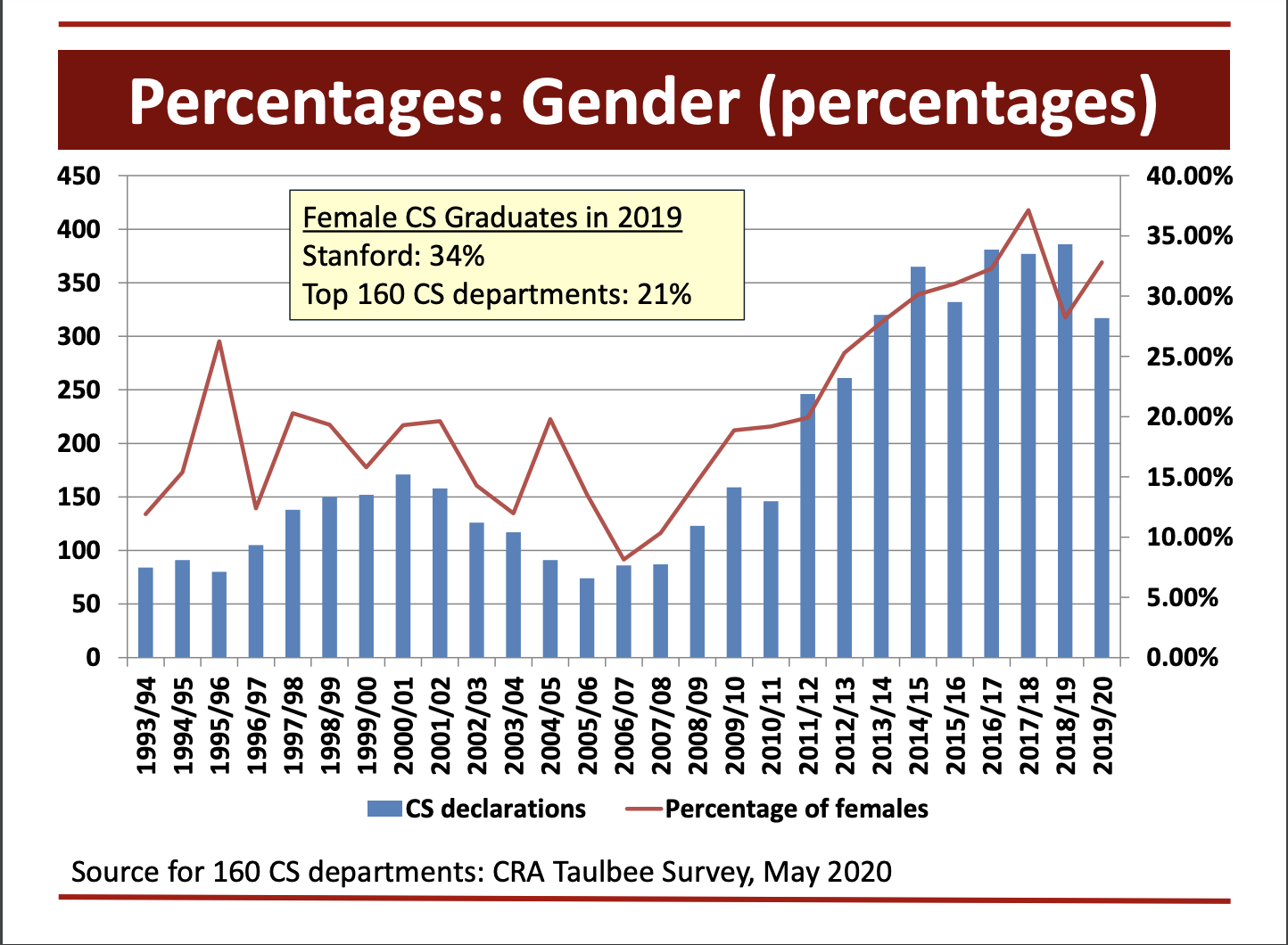Today: Last lecture, your future in CS, conclusions
Thanks To Ngoc and the Section Leaders
Thanks to Ngoc and the section leaders! The only way this course can work is with their prodigious and generous efforts. Ngoc and the section leaders are a tribe selected for technical skill and generosity - a fantastic group of people and we are lucky to have them.
Final Exam
- Mon Dec 9th, 10:00-11:30 am
- See course page for steps
Need to sign up for exam slot
- Similar structure to midterm
1.5 hours, closed note
Enough time to write code, not extra time
- Covers the whole quarter, weighted towards post-midterm
- Improved final exam score can compensate for a poor midterm score
- Exam problems look like homework functions
- Not on final exam:
Bit
Writing main()
Calling AI specificically
But Dict is fair game (Edit: not doing JSON on exam)
- See course page for review materials: final-prep, previous exams
Lots of problems for practice
You should study, useful code patterns anyway
- Section this week - work some review problems
Python Guide
I'm gradually working on and expanding the Python Guide, aiming to keep it as a free resource on the web. If you want to find it in the future, it's linked from my home page and the CS106A page.
What is the Role of CS106A?
- Disclaimer
- CS106A is not about browbeating people into liking CS!
- CS106A should lay out CS honestly
See the nature of code
See how to solve this problem
- And then you pick what's best for yourself
- Many Stanford students take one or two CS courses, and that's it
- We will not give you a reproachful look about your choice of major
Computers - Now You Know
- Things said on the first day you now know
- The computer just follows mechanical instructions
- There will be bugs
- Yet the results can be magic (under the programmers direction)
- We've done this so much, you know it in your bones
You will never not know this nature of the computer. Even if you never write another line of code.
Learned All The Programming Techniques?
Sadly, no.
Learned the Important Core
Here is the deal: Python and the space of all programming techniques is very large. A bigger space than you might think. The "Programming Python" book is over 1600 pages long. Fortunately, many of these features are for rare cases, you do not need to know them to get things done.
You have learned the most important 80% core: loops, lists, strings, functions, tests, files. There's a few more important techniques in CS106B, in particular, recursion.
Lookup More Niche Techniques
You know the core features. If you need to use a less-common technique, you may look it up and figure out as you go. That's how most programmers proceed - the core they know well, the other stuff they look up as they go.
Women in CS Trend - 1994 - 2020
Slide from Mehran Sahami. The blue bars is number of students. The red line is the percentage of women. Both are going up which is great, and it looks like a gradual broadening of the field.

Fact: Programmer Shortage
- A somewhat surprising fact for you to internalize
- What percentage in the US work as programmers?
- Walking around Stanford .. you would think it's like 25%
- Approximately 1% of the population work formally as programmers
Formal "programmer" jobs in the US statistics
There are additional programmer-adjacent jobs, but still a tiny number
- For comparison approximately 12% of population works in health care
- Lots of programming problems are not being solved due to lack of programmers
- In other words, there is a programmer shortage
Very high pay for programmers is another bit of evidence of the shortage
- You may notice this someday, trying to get an app built for your organization
- Not that we need to make any Stanford student's head any bigger...
- But by these numbers, knowing Python makes you a little special
Why is there a Programmer Shortage?
- Coding seems impossible, intimidating
- People are scared off before trying, weird syntax
- Don't see themselves as programmers, lack of role models
- Maybe they tried it and just don't like it! ("agency")
Nick Python T-Shirt Story
I was on a bicycle, wearing ratty clothes and a "Python" t-shirt stopped for a red light. A person walking in the cross-walk in front of me, stopped, turned to me, and asked if I was looking for work.
Not to disillusion you about graduating from Stanford, but that is not how hiring is normally done.
Like how desperate for programmers was that person? That is what an extreme programmer shortage looks like!
Free Breakfast Story
When I worked at Google, there was a nice free breakfast available at the office. The free breakfast would end at 10am. The funny part is that some people would complain .. the free breakfast cuts off too early, how am I supposed to get here by 10am?
What does this story tell you? That google cares about the morning nutrition of its team? Or that google is spending money on entitled nerds in the face of a desperate programmer shortage.
I suppose the other lesson is that it is human nature to grow accustomed to whatever blessings one has in life, and then risk seeing them as entitlements.
AI and Coding
We are at the beginning of the AI transition - we've just seen rapid advances, and should expect more change ahead. Keep this in mind trying to make predictions.
"It is difficult to make predictions, especially about the future." - Yogi Berra
Fact: today an AI can write chunks of code that are a good start, especially for common code patterns, and then the AI code needs some fixing. No doubt that will be a productive coding strategy in the future, a sort of AI+human team. Indeed, such AI+human patterns maybe describes how AI works in many endeavors.
I also appreciate that the basic loop/logic knowledge taught in CS106A are useful for the human in this AI+human strategy.
AI Eliminate Programmer Jobs?
Here is my guess about AI and programmers.
I think the AI makes programmers more productive, but does not remove the need for programmers.
Partly because this is, say, a 2x increase in productivity, not the AI eliminating the need for the programmer to make the thing work. Partly because the unmet demand for programmers is so large, that even with 2x productivity boost, you still need a lot of programmers.
Or we could consider the story where AI dominates. Suppose the AI can just write the code with very little need for a human to contribute. That would put a real dent in the demand for programmers. I don't see that happening, but this is all just speculations about the future. The same story applies to books, movies ... does the AI dominate the space, or is most work done as an AI + human hybrid.
Background: Many Computer Languages
- There are many different computer languages
Python, C++, Javascript, Java, C, Rust
- Each language is good at different things
Python Niche - Programmer Efficient
- Python is great at letting the programmer express their ideas with minimal code
- At what cost?
- Python runs slow and uses more memory than code in other languages
- In some sense, shifting costs from the programmer to the computer
- That's a great tradeoff in many situations!
Code Ideas We've Seen in Python
- Code ideas we've seen in Python
- Storing data
ints, floats, strings, lists, dicts
- Language features:
functions, parameters, strings, loops, if-logic, lists, dicts
- Good programming style:
Divide and conquer, decomposition
Testing functions
Readability
Your Second Programming Language
- Your second computer language
C++ or Javascript or Java or whatever..
- Has those some features:
ints, loops, strings, if-statements, ..
- Computer languages are 80% similar to each other
- Different syntax - superficial
- Your second language is surprisingly easy to learn
(you may be skeptical)
- Python has a "light" syntax
other languages have more to type in
- C++ (CS106B)
Here is some C++ code
// comments start with 2 slashes
int i = 0; // must declare var
while (i < 100) { // parens + braces
i += 1; // same as py + semicolon
if (is_bad(i)) { // parens + braces
return;
}
i += "Hello"; // error detected
// int/string types different,
// so above does not work.
// Error is flagged at edit-time:
// earlier than python, an improvement
}
- C++ code looks different
- Actually 80% familiar
- Picking up C++ will not be a big problem
- Advantage of heavier syntax: more automatic error detection
- Also C++ runs much faster than Python
- Disadvantage: more to type in
- Fun fact: the Python interpreter is itself written in the language C, related to C++
Possible Next Steps
Most Stanford students take 1 or 2 CS classes and keep with their chosen major. It's easy to imagine they use Python here and there as part of their work.
After CS106A ..
- Interested in more coding techniques and CS .. take CS106B
See how far you like going
- Hidden agenda:
Many students coming to Stanford don't see themselves in CS
CS106A tries to pick off a few was-not-planning-to-like-CS students
Next "CS106" CS106B
- The next step in CS - mixture of coding and CS
- Coding problems are harder and more impressive compared to 106A
- Has section leaders
- Many non-CS-majors take this
- More powerful algorithms
- Uses C++ language - don't worry about this
- Recursion (beautiful) .. e.g. solving a maze
A sort of jaw-dropping idea when you get it
- Really understand: hash table (dict), sorting algorithms
- Just more programs built - makes you a stronger programmer and debugger (reps)
- Recommend you take it within 1 or 2 quarters
Aside: Selecting A Major
How do you feel, finishing each CS106B project. There are many ways to pick a major. One angle is - you should enjoy the main topics that make up a major.
Think About Section Leading
- Few schools have this opportunity
- Section Leader program - amazing thing at Stanford
- Section leaders are drawn from students who have completed CS106B
Don't need to be a CS major
- Section leaders - not for everyone
like code, like helping people
- Open secret: SLs pick up fantastic skills
debugging, organizing ideas, public speaking, confidence
CS Major - Code and Math Tracks
- Programming core sequence:
CS106A, CS106B, CS107, CS111
- CS Mathematical core sequence:
CS103, CS109, CS161 (integer mathematics, probability)
- Then there are more courses in an area of concentration
Next Course FAQ
- Programming courses tend to take in order
CS106B, CS107, CS111
- CS106B and CS103
You can take these at the same time, but they are hard
Don't take another hard class at the same time though
- CS103 and CS109
CS103 is basic integer mathematics
CS109 is more probabilistic structures
CS109 prerequisite is either CS103 or Math 51, so can take CS109 without CS103 if you like
- Nick editorial vs. 19 units
Every student is different and selects their own college strategy
Some students take 19 units, but they struggle to do a high quality job on all their courses
Alternative: student taking 14 units, but they are very on top of their courses
Aside: What is CS Integer Mathematics?
- CS Integer mathematics (vs. calculus real-number)
int div and mod (// %)
- Hash Table (dict) - how is this so fast?
- Not so much: integrals, differential equations
- Calculus is not the ceiling, it's a branch
- Integer mathematics is its own domain
- Relates to list/string algorithms we've done
- Personal take:
I was tired of Calculus, but integer mathematics seemed neat and applied
- CS106B goes down the path of integer mathematics a little
CS Major Tracks / Concentrations
- If interested in majoring in CS
- Don't have to pick an area at first
- Undergraduate CS concentration areas:
Artificial Intelligence (AI)
Human Computer Interaction (HCI)
Systems (operating systems, networks)
Graphics
Biocomputation
Theory
- Choose a concentration, take advanced courses in that area
- HCI - call this one out, since most don't realize this field exists (below)
- CS Minor is a good deal
Up through CS107 and CS109 + 2 electives
This gives a strong CS background
Minor is a better idea than double-major
Some Select Courses
We'll just mention a few courses you could take, build the picture that there are many different areas of CS you might explore. Many of these require CS106B as the pre-requisite.
Scientific Python CME 193
- Python and scientific computing
- Prereq: CS106A basically
- 1 unit s/nc
- Applied Python (vs. CS fundamentals)
- See CME193
Applied Machine Learning CS129
- Machine Learning is the cutting edge AI technique
Drawing conclusions from data
- Prereq: CS106B, linear algebra / Math 51
- See CS129
Human Computer Interaction (HCI) CS147
- How to design systems to work well with humans
- Details below about HCI
- Prereq: CS106B
- See CS147 intro HCI
Graphics CS148
- 3d imagery
- Prereq: CS107, Math 51
- How does Mario Cart work?
- See CS148
Human Computer Interaction - HCI Design
- What if you don't want to write code all the time?
- An unexpected part of CS
- Human Computer Interaction Design
- Anyone working in management in a computer field should take this course
- You can do an undergrad or grad emphasis in HCI
- More info: CS147 intro HCI
- aka "interaction design" - product manager, designer
- Demo Image search: push pull handle HCI
- Door Push-Pull Handle
- The appearance communicates to the subconscious
- Great design works without the user thinking!
(analogy: film making to create an emotion in the audience)
- Mostly we notice HCI in the world when it is done badly
You click a control, and are surprised by what happens
- Nick's Open Question: what is the greater drag on human potential on Earth:
Missing software, not coded up yet (CS106B)
Software with bad HCI design (CS147)
Symbolic Systems Major
A sibling to the CS major - similar intellectual domains but less focus on coding
An interdisciplinary major that uses the lenses of CS, Philosophy, Psychology and Linguistics to study systems that use symbols to represent information. In Symsys you can concentrate on AI, Neuroscience, Natural Language, Philosophical Foundations or design your own concentration.
Self-Driving Cars - Machine Learning
- I think this will work someday, at least for freeways
- A vision / radar problem - see all the possible collisions
- Machine Learning to try to recognize the things around the car
Needs to work for 100% of Cases
Part of getting code to work is that you need to chase down those rare, difficult cases as well.
Below is a difficult case for the self-driving logic, although all the people in the audience understands what they are seeing easily.

Where is the Magic in CS?
- The computer seems magic
- Such neat output
- But where is the magic?

Where is the Insight? The Power?

Where is the power in this story?
- You are the power in this story
- You have an insight about a problem to solve in the world
- Your idea makes the algorithm
- Python is just your instrument
- The computer solves a real problem, driven by your idea
- This is great story
Fare Well Python Programmers!
In closing, I'll say that teaching this class is very satisfying endeavor - it's great to see the light in someone's eyes when the power we know in CS starts working for that student.
Best of luck with your future projects!




